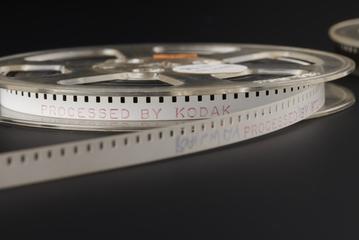
16mm film, original master ‘Air Raid Precaution, repairing permanent way: Repairing bomb damage to the line in presence of mustard gas, reel 1 of 3’
- PART OF:
- Collection of ARP Films
- Made:
- 1940-1941 in United Kingdom
16mm original film, black and white footage edited with splices, descriptive captions and explanatory drawings. 500 feet on 800 feet plastic canister (approximately 14 minutes). Part 1 according to captions.
Training film for ARP as captions describe the safety procedures addressing directly the men and showing images of trained and well-equipped workers, showing district engineer and gas safety officer going first on the damaged site, and what they do before the APT team can work on repairing the site, etc; also description of the different gears and equipment. Captions: 1. London Midland and Scottish Railway (credit). 2. Repairing Bomb damage to the line in the presence of mustard gas (title). 3. This film, taken during a demonstration at Medbourne, Leicestershire, shows how a repair gang can carry on its work in the presence of mustard gas, provided that it has been properly trained and equipped. 4. A crater due to an H.E bomb was contaminated with actual mustard. No one suffered any harm - and you will seldom meet with worse conditions. 5. Oilskins, gumboots and gloves gives protection against contact with the liquid, whilst the respirator and a special form of overall suit guard against the vapour risk. 6. The District Engineer and his staff accompanied by a Gas Safety Offcier (G.S.O) arrive to determine the extent of contamination and to decide on the method of working. 7. You will see the G.S.O exploring the site for signs of liquid contamination. He uses a prodding stick on the end of which pieces of detector paper are fixed. 8. 'Gas danger' boards are set up to mark the extent of the dangerous area, Men should not enter this area unless wearing respirator and protective clothing. 9. A smoky fire is lit near the crater to show the wind direction and indicate the spread of the mustard vapour. 10. Bearing in mind the direction and strength of the wind, the G.S.O decides how close the A.R.P units etc. may be brought to the site. 11. The Engineer's repair gang and the S&T engineer's men are brought to the scene in the Northampton A.R.P unit attached to the ballast train. 12. During the journey, the men change into their protective clothing, assisted by the dressing staff who accompany the train. 13. Each man is given a number and his equipment is marked accordingly. 14. The men emerge fully dressed from the A.R.P unit as soon as it arrives. Each wears the overall suit underneath oilskin clothing of which several types are on trial. 15. You will now see the heavy anti-gas suit. It gives good protection, but is difficult to work in when the weather is hot. 16. The next man wears a light anti-gas suit consisting of a short coat and leggings. 17. Finally, there is a man wearing an anti-gas cape and leggings. This equipment is reasonably cool to work in, but the cape is too full and liable to tear. 18. Tools are carried in a special tool van and are arranged so that they can be handed out with the minimum of delay. 19. In a moment you will see two of the decontamination squad, dressed in long black oilskin coats, place a tray of bleach a short distance outside the contaminated area. 20. All men coming from the contaminated area must pass through this tray to prevent the spread of liquid mustard. They also keep to the path marked 'dirty'. 21. Men wheel up the tongs for handling the sleepers and rails while others shovel out ashes from the end wagon into the crater. 22. Notice the hoods are worn by the men working in the high vapour concentration near the crater. 23. Next you see S&T men preparing to fix a temporary line on the nearest pole affected by the explosion. 24. Note the tent which provides shelter for men resting. 25. Each half hour the working shift is relieved. The men pass through the bleach tray to prevent the spread if liquid contamination. 26. End of reel one.
Part of a collection of Air Raid Precaution instructional films and footage made by the London Midland and Scottish Railways during World War 2, retained by British Rail Research Laboratories, Derby, alongside British Rail Research own production of technical films. This ARP collection includes edited original films and offcuts.
Details
- Category:
- Moving Images
- Object Number:
- 1978-7635/5
- Materials:
- plastic (unidentified) and cellulose acetate
- Measurements:
-
overall: 20 mm 300 mm,
- type:
- 16 mm film
- credit:
- British Rail, Research Laboratories
